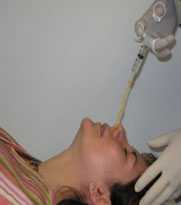Diagnosis and Treatment
Español: Diagnóstico y tratamiento
Diagnosis
Healthcare providers diagnose pertussis (whooping cough) by considering if you have been exposed to pertussis and by doing a:
- History of typical signs and symptoms
- Physical examination
- Laboratory test which involves taking a sample of mucus (with a swab or syringe filled with saline) from the back of the throat through the nose — see Figure 1 and video demonstrations
- Blood test

Figure 1: Proper technique for obtaining a nasopharyngeal specimen for isolation of Bordetella pertussis
Image: Manual for the Surveillance of Vaccine-Preventable Diseases, 4th ed, 2008
Treatment
Healthcare providers generally treat pertussis with antibiotics and early treatment is very important. Treatment may make your infection less serious if you start it early, before coughing fits begin. Treatment can also help prevent spreading the disease to close contacts (people who have spent a lot of time around the infected person). Treatment after three weeks of illness is unlikely to help. The bacteria are gone from your body by then, even though you usually will still have symptoms. This is because the bacteria have already done damage to your body.
There are several antibiotics (medications that can help treat diseases caused by bacteria) available to treat pertussis. If a healthcare professional diagnoses you or your child with pertussis, they will explain how to treat the infection. Learn more about pertussis treatment recommended by CDC.
Pertussis can sometimes be very serious, requiring treatment in the hospital. Babies are at greatest risk for serious complications from pertussis. View photos of a baby getting treatment for pertussis in the hospital.
If Your Child Gets Treatment for Pertussis at Home
Do not give cough medications unless instructed by your doctor. Giving cough medicine probably will not help and is often not recommended for kids younger than 4 years old.
Manage pertussis and reduce the risk of spreading it to others by:
- Following the schedule for giving antibiotics exactly as your child’s doctor prescribed.
- Keeping your home free from irritants – as much as possible – that can trigger coughing, such as smoke, dust, and chemical fumes.
- Using a clean, cool mist vaporizer to help loosen mucus and soothe the cough.
- Practicing good handwashing.
- Encouraging your child to drink plenty of fluids, including water, juices, and soups, and eating fruits to prevent dehydration (lack of fluids). Report any signs of dehydration to your doctor immediately. These include dry, sticky mouth, sleepiness or tiredness, or thirst. They also include decreased urination or fewer wet diapers, few or no tears when crying, muscle weakness, headache, dizziness or lightheadedness.
- Encouraging your child to eat small meals every few hours to help prevent vomiting (throwing up) from occurring.
If Your Child Gets Treatment for Pertussis in the Hospital
Your child may need help keeping breathing passages clear, which may require suctioning (drawing out) of mucus. Doctors monitor breathing and give oxygen, if needed. Children might need intravenous (IV, through the vein) fluids if they show signs of dehydration or have difficulty eating. You should take precautions, like practicing good hand hygiene and keeping surfaces clean.
Related Page
- Page last reviewed: August 7, 2017
- Page last updated: August 7, 2017
- Content source:


 ShareCompartir
ShareCompartir